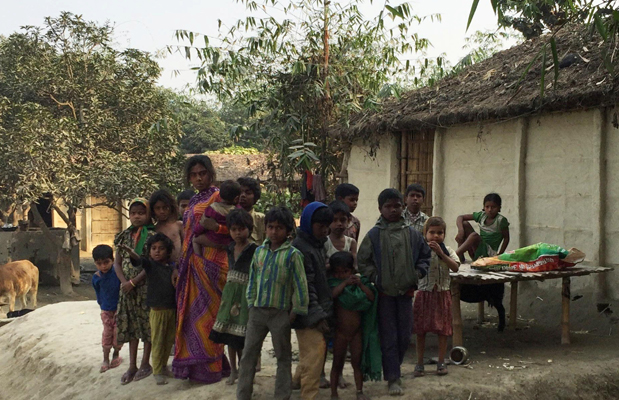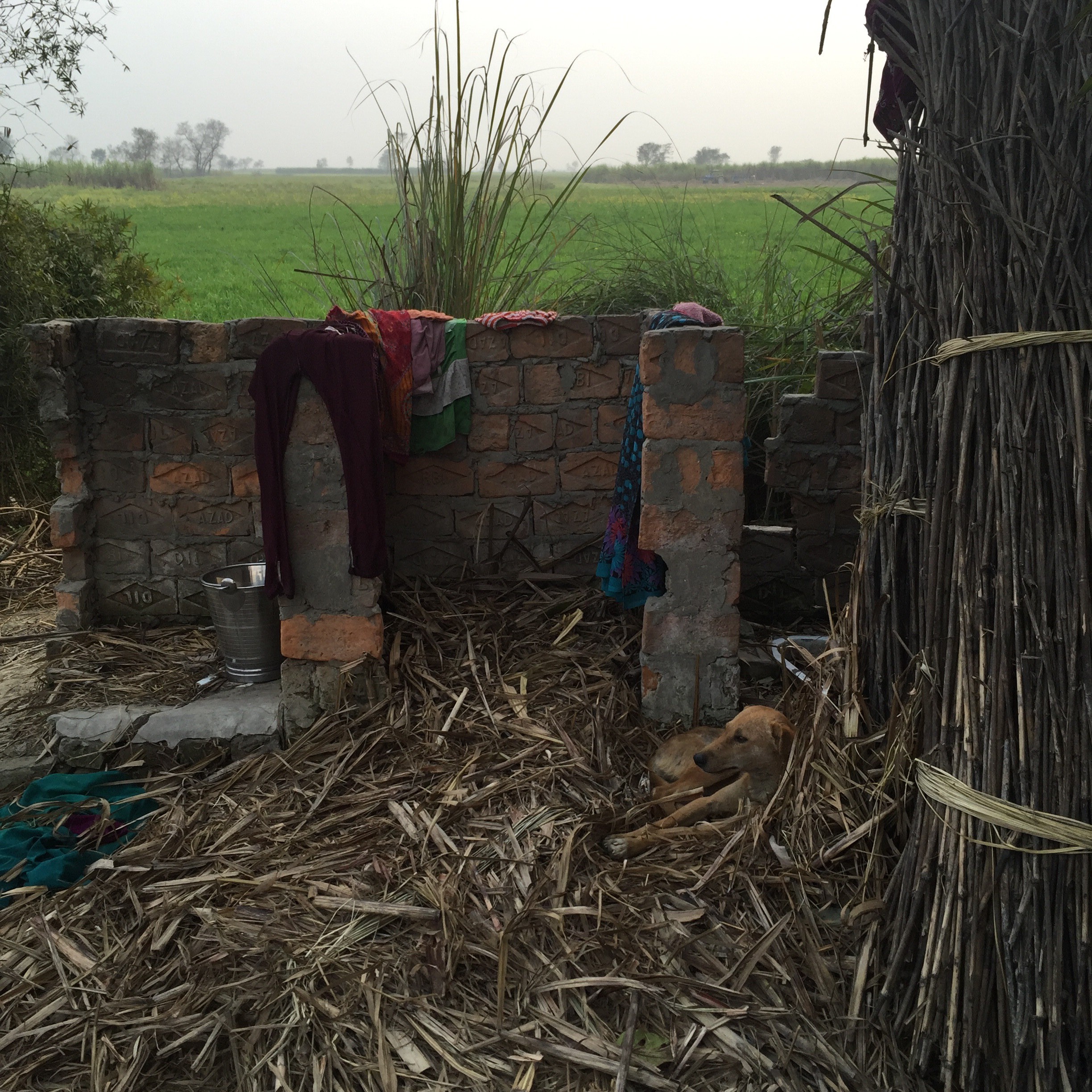By Giovanna Gioli and Amina Maharjan, ICIMOD
 Sunset over Gandaki. (Photo: Giovanna Gioli)
Sunset over Gandaki. (Photo: Giovanna Gioli)
As we enter the small revenue village of Chharki, we are welcomed by swarms of children. Many of them are only half dressed, or even completely naked, their faces covered with dust. Some, the youngest, have visible pot-bellies, a definite sign of malnutrition. Chharki is located between the embankments, only a few hundred meters away from the banks of the Gandaki River. We walk up to the river, crossing the yellow mustard fields, the Gandaki bathed in a golden aura.
The entire community of Chharki is made up of displaced people coming from nearby villages that were washed away by floods over the past 20 years. Most of the communities residing inside the embankments are caught in a cycle of constant displacement and adapt to a precarious life where the river, the land and their livelihoods interact in ephemeral and constantly changing ways, leaving them with only one (almost) certain constant: their labour.
The constellation of precarious settlements inside the embankments, their materialisation and sudden disappearance have been powerfully compared to diyas, oil lamps, floating from one place to the other, following the moody course of the Gandaki River. A displaced community relocates in an equally (if not more) vulnerable strip of land inside the embankment.
How do these communities experience the precariousness of their lives, and how are they resisting it?
Bihar is a land of contrast, characterised by poor economic performance despite being endowed with rich natural resources and fertile land. And land lies at the core of the ‘Bihar paradox’. The roots of economic marginalisation can be traced back to the colonial era and the establishment of an exploitative landlord class which constantly resisted economic and social development (Rasul and Sharma 2014). Unequal access and control over land persisted even though zamindari was statutorily abolished in 1952. Land control remained in the hands of dominant castes, and the only outcome of the land reform was to “broaden the base of the land control to include also upper layers of the middle castes” (Chakravarti 2013: 1452).
 Villagers in front of a house whose foundation has been raised. (Photo: Giovanna Gioli)
Villagers in front of a house whose foundation has been raised. (Photo: Giovanna Gioli)
Several studies have shown how caste is still a valid indicator for land control in Bihar. Agrarian class relations are embedded in caste, and substantial populations in rural Bihar— especially landless agricultural labourers—continue to be subjected to extreme forms of exploitation (see Chakravarti 2013).
Chharki’s villagers belong mostly to the agrarian “underclass” described above and comprise of dalits, mahadalits and Other Backward Classes (OBCs). We observed that almost all the houses in the village were kacchi (built with bamboo and mud) and that the village settlements were stratified along caste lines. The first homes we encountered as we entered Chharki all belonged to mahadalits and dalits. These houses led to those belonging to OBCs and finally, towards the tail end of the village, to those that belonged to the few “upper caste” families (Rajputs, Yadavs) who live there. Two of the only three pukka houses in the village belong to them. The third belongs to a Mallah family— traditionally, the lives of the Mallah people revolved around boating and fishing, although this is not the case anymore.
This stratified caste system seems to be directly related to land ownership in the village. A few families control large portions of the land while most families own negligible plots or no land at all. They work as sharecroppers (harijans) or as off-farm wage labourers and they live in perennial uncertainty, a constant trepidation at the possibility of the river reclaiming the land.
The river is both a blessing (its silty banks make for naturally fertile agricultural land) and a threat (there is always the chance that it will flood and claim not just the villagers’ livelihoods but also their lives) to the people of Chharki. Still, those who own land in the village do not want to abandon it. Land is the most important thing to them. Land is power, and despite the uncertainties and the hardships, Chharki’s villagers do not want to move out of their land or any piece of land that they might one day aspire to, as the cycles of flood may sometimes even play a role in land redistribution.
Hazards scholars and political ecologists have long argued that there is little “natural” in natural disasters. Floods are political events, and their consequences are exacerbated by structural inequities and conditions of structural violence. Those who are trapped between embankments—the inhabitants of the ‘floating villages’—have little choice than to stay and ‘adapt’ to the cycle of displacement and losses caused by floods simply because this is where their agricultural land is. These villagers are painfully aware of the fact that life beyond this socio-ecological niche is likely to be even harder for them. Measures such as raising the foundations of their homes and storage huts to prevent rising floodwaters from causing damage, as well as storing the most essentials things on the uppermost parts of their houses are commonly adopted by villagers. The houses we visited were eerily almost empty of assets, as if people did not live there. The essentiality of these households speaks volumes not only about poverty per se, but also about a specific form of precariousness where poverty meets extreme vulnerability in a downward spiral where each term reinforces the other.
 Foundation, storage place and bed. Foundation, storage place and bed. (Photo: Giovanna Gioli) |
 Public toilet in Chharki. Public toilet in Chharki. (Photo: Giovanna Gioli) |
Livelihood diversification, in this context, proves to be a crucial factor. Villages such as Chharki are floating through cycles of displacement, uncertain landholdings, damages and losses. And because the villagers have only their labour to rely on, the people too are constantly on the move. Despite high costs and the inevitable uncertainties, there is at least one male member missing from almost every household in Chharki. Men of working age migrate seasonally to Indian cities like Punjab, Haryana and Delhi or to neighbouring Nepal where they work mostly as agricultural labourers and construction workers.
In many ways, labour migration literary provides escape from local constraints, as well as a safe pipeline (self-insurance mechanism) during emergencies. Adding a new spatial dimension to the local geographies of vulnerability means to be able to mitigate their exposure to economic and environmental shocks, Remitted money might also be used to lend a certain form of stability to their floating lives, allowing, for instance, a family to turn their mud house into a pukka home and making the possibility of eviction less threatening. This highlights the need for more comprehensive studies on the complex (two-way) interrelations between land ownership and human mobility.
Specific gender vulnerabilities need to be highlighted as well. While men undertake the risky migratory journey, women stay put and work in the fields, takes care of their families and livestock. With an average of six to eight children per household, lack of education, health and sanitation facilities (including toilets), women face a specific set of challenges, resulting, among other things, in neglected (reproductive) health and deprivation. Households headed by women are more likely to be caught in a vicious cycle of poverty, debt and exploitation, without active male members even migration option is curtailed for these households. The feminisation of poverty has to be looked at and understood in the context of the precarious lives of the people of Chharki and their differentiated access to mobility.
References
-
AnandChakravarti (2011) Caste and Agrarian Class: A view from Bihar, Economic and Political Weekly 36(17): 1449-1462.
-
Golam Rasul & Eklabya Sharma (2014) Understanding the poor economic performance of Bihar and Uttar Pradesh, India: a macro-perspective, Regional Studies, Regional Science, 1:1, 221-239, DOI: 1080/21681376.2014.943804
Related blog by the same authors:
Dreaming of a Better Life Outside the Gandaki Embankment
